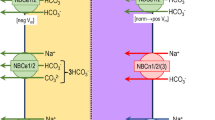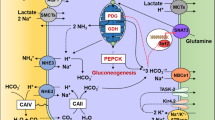Abstract
Hypotonic shock (change of osmolality from 600 mosmol to 300 mosmol by lowering NaCl concentration) increases the release of organic osmolytes from isolated inner medullary collecting duct (IMCD) cells in the following sequence: taurine > betaine > sorbitol > myo-inositol > glycerophosphorylcholine (GPC). The role of G-proteins in regulating the hypotonicity-induced efflux was analysed by exposing cells to various concentrations of a G-protein inhibitor, pertussis toxin (PTX; 20–200 ng/ml), and a Giα-protein stimulator, mastoparan (10–50 μM). PTX diminished the hypotonic release of sorbitol and betaine by 43.2±9.5% and 32.2±7.8% (n = 5), respectively. Efflux of GPC, myo-inositol and taurine was not significantly altered. Mastoparan (10 μM) increased osmolyte release under isotonic conditions such that release of betaine was increased 3.8-fold and that of sorbitol 2.1-fold, while GPC, myo-inositol and taurine effluxes were only slightly augmented. Under hypotonic conditions, mastoparan stimulated betaine release (1.86±0.2-fold, n = 5) but not that of sorbitol. As tested in connection with sorbitol and betaine release, the effect of mastoparan was abolished by PTX, but not the A23187-evoked sorbitol release. Like mastoparan, arachidonic acid increased the release of sorbitol and betaine under isotonic conditions, but under hypotonic conditions it only increased the release of betaine. As to the role of intracellular Ca2+, hypotonic shock evoked an intracellular Ca2+ peak which could be prevented by PTX. Mastoparan increased intracellular Ca2+ under isotonic conditions, whether the extracellular Ca2+ concentration was low or high. The results indicate that G-proteins are involved in regulating sorbitol and betaine efflux from IMCD cells. The G-proteins regulating sorbitol release are probably involved in generating the proper intracellular Ca2+ signal. Betaine efflux, which is independent of intracellular Ca2+, might be regulated by a G-protein-stimulated release of arachidonic acid. Thus, probably several G-proteins are involved in controlling organic osmolyte efflux from IMCD cells.
Similar content being viewed by others
Author information
Authors and Affiliations
Additional information
Received: 2 April 1996 / Received after revision: 30 June 1996 / Accepted 25 July 1996
Rights and permissions
About this article
Cite this article
Ruhfus, B., Tinel, H. & Kinne, R. Role of G-proteins in the regulation of organic osmolyte efflux from isolated rat renal inner medullary collecting duct cells. Pfluegers Arch 433, 35–41 (1996). https://doi.org/10.1007/s004240050245
Issue Date:
DOI: https://doi.org/10.1007/s004240050245




